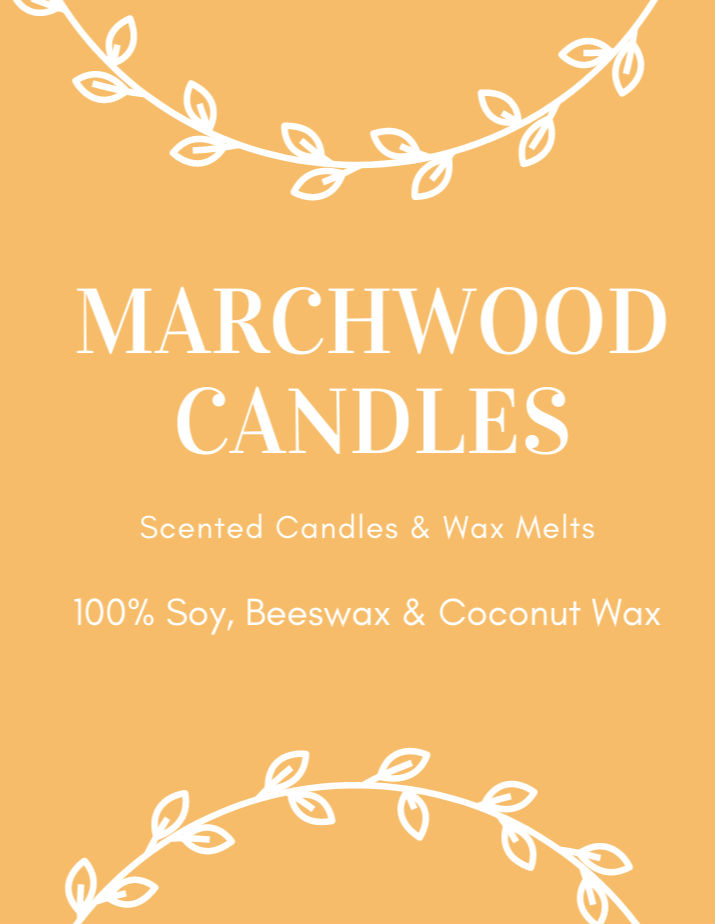The Art of Candle Making
- Marchwood Candles

- Apr 14
- 4 min read
Candle making is an intricate art that encompasses much more than merely selecting appealing scents; it is a multifaceted process that resembles the principles of chemistry, requiring meticulous attention to a myriad of variables that can significantly affect the final product. The journey begins with the selection of wax, as there is a diverse range of waxes available, including paraffin, soy, beeswax, and palm, each possessing unique properties and characteristics. Each type of wax necessitates thorough testing with various factors to ensure that the candle is indeed "Safe to Burn." Temperature plays a pivotal role in the candle-making process. Mastering the intricacies of temperature control can lead to a flawlessly smooth surface on the candle, devoid of unsightly sinkholes that can detrimentally impact the wick's performance and, consequently, the overall burn quality of the candle. The wick itself is another critical element that often presents challenges for chandlers. Choosing the right wick is essential, as the material, size, and type can influence how well the candle burns, its flame size, and its ability to draw wax up to the flame efficiently. In addition to the core components, there are numerous additives to consider that can enhance the candle's aesthetic and olfactory qualities. Fragrance oils must be carefully chosen and measured, as their concentration can dramatically alter the scent throw and overall performance of the candle. Biodegradable dyes, mica powders for shimmer, and even dried flowers can be incorporated, but each of these additions impacts how the candle burns and how the wax behaves when heated. This complexity means that candle making is a lengthy and sometimes laborious process, where every test and result must be meticulously documented to ensure safety and consistency in the final product. For those who are passionate about this craft, sharing the results of testing on platforms like Instagram can provide valuable insights to others in the community. It fosters a sense of transparency and encourages collaboration among candle makers. However, the testing does not stop at scent and aesthetics; container testing is equally crucial. It is imperative to ensure that the chosen containers, particularly glass ones, are devoid of hairline cracks and are safe for candle use. This involves rigorous examination to confirm that the container can withstand the heat generated during the burning process without compromising safety. It is essential to acknowledge that candles, while they may seem benign, are indeed fire hazards and can potentially explode if not made with care and precision. Various considerations must be taken into account, including flame size, wick position, the phenomenon known as mushrooming (where the wick charred tip becomes enlarged), the presence of black rims on the container, and the temperature of the container throughout the burning cycle. Additionally, the effects of UV light on certain dyes or additives cannot be overlooked, as prolonged exposure can alter the appearance and performance of the candle. In conclusion, candle making is a sophisticated blend of art and science, requiring a deep understanding of materials, safety protocols, and the chemistry of combustion. Each step in the process, from selecting the wax to testing the final product, is critical to creating a beautiful and safe candle that can provide warmth and light without compromising safety.


While I adore Soy wax
in candles for its natural properties and eco-friendly credentials, I must admit that I am not particularly fond of the frosting that sometimes develops on the surface, especially when it comes to my wax melts. The frosted appearance can be visually unappealing to me, detracting from the overall aesthetic that I seek in my home fragrance products. The texture and look of the wax can significantly influence my enjoyment, and I often find myself preferring a smoother, more uniform surface that enhances the visual charm of the melts.
In my quest for the perfect wax melt, I recently discovered a new favourite

that has completely changed my perspective. This delightful blend is made from Coconut and Rapeseed wax, which offers a stunning creamy appearance that I absolutely love. The creamy texture not only looks appealing but also adds an element of sophistication to my collection of wax melts. What sets this blend apart is its commitment to being free from soy and palm-derived materials, which is an important factor for those who are conscious about sustainability and the environmental impact of their choices. Additionally, it contains no additives, ensuring that I am using a product that is as pure and natural as possible.
One of the standout features of this Coconut Rapeseed blend is its remarkable hot throw. When burned, it releases a fragrance that fills the room beautifully, creating an inviting atmosphere that is hard to resist. The scent disperses evenly and efficiently, making it one of the best hot throws I have ever experienced in my journey with wax melts. The combination of the creamy look and the powerful scent throw makes this wax blend a perfect addition to my home fragrance routine. Overall, I am thrilled to have found a wax melt that not only meets my aesthetic preferences but also performs exceptionally well in delivering delightful aromas throughout my living space.


